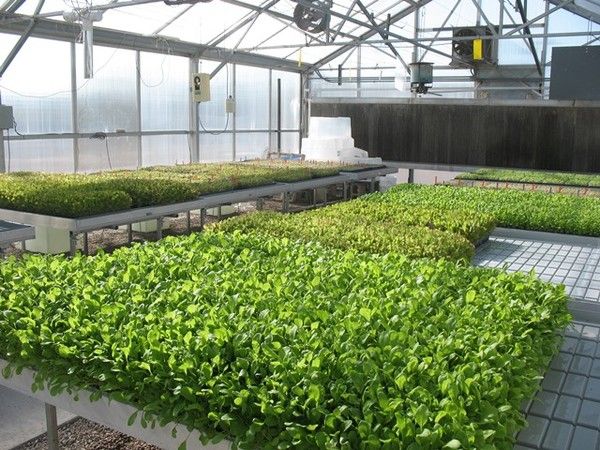
In the Greenhouse: Transport and Spraying
Large-scale crop growing under glass has major transport, spraying and harvesting requirements and, where spraying in an enclosed space is harmful to a human spray operator, robots are the answer
Growing crops under glass is far more intense and demanding than almost any other crop operation found on the farm. Even raising flowers and vegetables in cold tunnels cannot match it. In a greenhouse, each day’s work is of the maximum importance; there is a precise schedule to be followed. To keep on schedule, transporting the necessary material is key –not just soil, fertiliser, pesticides, and in some cases water for irrigation, but also the harvest and carrying it to where processing will begin. And it must all be done without damaging the produce or the facilities.
The challenges find a natural response in a high level of automatisation, and even the introduction of robots. But, given the enclosed spaces, adopting power sources with zero, or at least minimal pollution becomes a necessity, to give adequate protection to the operator’s health. Electric vehicles are one of the best options. Manufacturers offer a range of products diversified in terms of how they move (wheeled, on rails, etc.), speed of movement, range, maximum load, engine power, type of power source, etc. The field is surveyed below.
On-Rail Platforms
One ingenious idea is to use the heating pipes found a few centimetres off the ground in most greenhouses as rails for a work platform, whose height can be varied by a scissors-type support (Fig. 1). In Italy, Aegon at the Piedmontese town of Cuneo imports Berg’s range of models from the Netherlands, with various dimensions and loads. Berg powers them with electric motors up to 370 W. The BRW185 has a long platform (1800 by 400 mm) and on board controls and can reach up to 1.70 meters higher than the command panels of which there is one on each side. They can be operated independently so that harvesting and other operations can be carried on both sides of a row of plants. Speed is controlled electronically in a range of 0-40 meters per minute, in both directions.
Tricycle Greenhouse Helpers
From Piacenza d’Adige near Padua in northeast Italy, Salf Macchine Agricole offers the Tucano, an electric tricycle powered by an engine supplied by power from an 800 W pack of 24 V batteries. A good choice for growing strawberries, tomatoes and the like under glass, the platform’s height can be regulated to get the right position with respect to the crop. The device is controlled by pedals, leaving the operator’s hands free. The speed is varied through a pneumatic device working on the front driving wheel, permitting a very small turning radius without harming the plants. On request, the tricycle can be set up for conversion from electric to manual operation, making for quicker turning at row ends. When on the move, the vehicle is pre-set to keep to a straight line. Other optionals are electric steering that can be regulated in height, a hydraulically raised central platform and supplementary hydraulic platforms.
Multi-wheeled Carts
Carts, like barrows, have hoppers in varying shapes, either rectangular with sloping sides or a truncated pyramid turned upside down. Carts, however, have three or four wheels of which one or two can pivot to improve turning. They work off a couple hundred watt of power from normal lead-acid batteries.
Climbcart from Villanovetta di Verzuolo near Cuneo produces the 108 range, a series of three or four-wheeled carts running an electronically controlled 600-800 W electric engine from 12 V – 50 Ah batteries linked in series. A set of oil bath gears with differential transmits the power, giving a speed of 0-5 km/h forward or in reverse. Leaving aside the gardener’s model, the vehicle can be supplied with ribbed tyres to improve grip. The pivoting front wheels improve steering. A load of up to 250 kg can be handled on slopes of up to 20%, and the operating range is put at about 30 km. If intensive use is needed, larger batteries of 80 Ah can be installed.
An ingenious feature is the magnetic brake which starts working a second after releasing the accelerator or when the emergency button is pushed. The magnetic brake also brakes the motor, even if a full load is being carried, when going downhill. The speed will not be allowed to exceed a maximum set by the operator. If the electrical power packs up, the magnetic brake can be bypassed to allow full manual control.
Single-wheeled Barrows
Modern versions of the traditional barrow carry about the same load- no more than around 100 dm3. They also have a single wheel, possibly with a ribbed tyre to improve grip on steep or broken ground. The electric motor with a reducer gear unit is almost always attached directly to the wheel’s hub. The normal power source is a 12 V 20-25 Ah battery, which provides enough power for a full day’s work.
Bravo, a product from Eurosystems at Luzzara near Reggio Emilia, can carry up to 120 kg, and forward speed can be regulated from the handles. A ribbed tyres makes it possible to handle slopes of up to 35%, and the engine acts as a brake on downhill sections, at the same time recharging the battery located under the hopper and protected from blowout by a 40 A fuse. The Bravo can also be pushed manually by disengaging the reducer unit from the wheel. One interesting accessory is a snowplough blade, 650 mm wide and 290mm high, fixed to the two bolts that hold the wheel on the frame.
Tracked Carts
These use more powerful electric engines of up to or over 4 HP since the loads to be handled are significantly heavier than the types mentioned above. Designed for professionals, they include useful functions such as hydraulic hopper emptying. But the most striking feature is the rubber tracks fitted to most, which give unsurpassed grip on slippery surfaces, but also reduce compaction where the soil surface is loose. One model is the Active 1460 Electro, a mini-dumper with rubber tracks powered by a 3 kW-24 V continuous current engine from two 85 Ah gel batteries. This package gives about three hours of operating time with a full load.
BOX – Robots for spraying
Regulations on pesticide and other spraying in closed greenhouses are evolving towards banning the presence of operators during spraying and for a given time afterwards. The only obvious alternative solution is programmed spraying devices, in other words, robots. Science fiction? Well, no. The Dutch company, Berg, has designed the Meto, a robot running on rails with all it needs to do the spraying. To avoid corrosion by the powerful chemicals used in the sprays, the machine is made of stainless steel. Programming is carried out on an easily accessible panel. The 370 W electric engine gets its power from a 24 V- 110 Ah battery pack. This produces speeds of up to 70 meters per minute for a distance of up to 140 meters, the available length of piping whose diameter can be up to half an inch.








